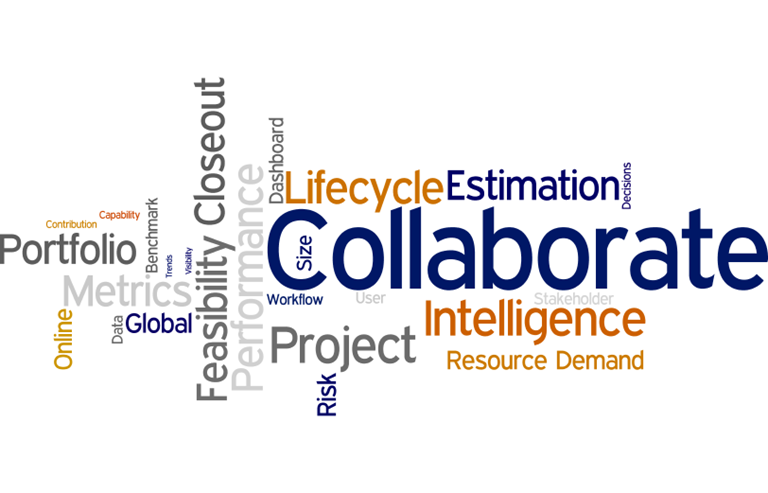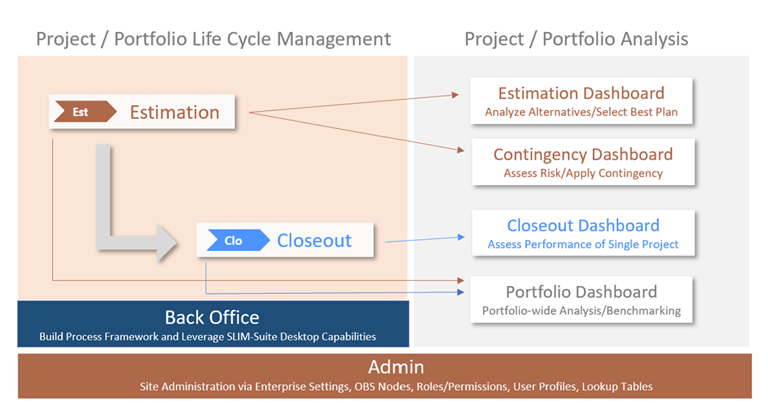
Software estimation is often seen as something of a “black box” with highly visible outputs (schedule, cost, effort), but murky and mysterious inner workings. It doesn’t help when the estimate assumptions are not well-documented or communicated to project stakeholders. Other challenges include ad hoc estimation practices, analysis and assumptions hidden in multiple documents and spreadsheets, and no easy way to align performance assumptions with demonstrated capabilities. But it doesn’t have to be this way!
QSM’s SLIM (Software Lifecycle Management) desktop tools have been helping organizations produce defensible, top-down estimates for decades. SLIM-Collaborate’s web-based user interface leverages the power of QSM’s robustly-featured desktop suite (see SLIM-Collaborate Project Lifecycle), simplifies the estimation process, and encourages participation from a variety of stakeholders. Business Intelligence applications help executives at all levels understand customer needs, trends, process effectiveness, risk, and more. SLIM-Collaborate provides project intelligence to any stakeholder, anytime!

Collaborate’s streamlined structure and simplified, online user interface equip more people in more positions and places with sophisticated project estimation and performance intelligence – improving visibility, transparency, and global collaboration. Providing a central access point for project data across lifecycle stages lends clarity to key characteristics of successful software organizations:
•Process – Well-defined, repeatable processes have identifiable inputs, activities, and outputs and are triggered by specific events. Estimation, project closeout, and management processes are built into Collaborate, supported by customizable workflow statuses.
•Goals – Software and system product development initiatives often begin as ideas. Often, project cost and schedule goals are more aligned with sales or business targets than proven performance. With SLIM-Collaborate, project goals and risk assessments are specifically identified, helping stakeholders analyze something more concrete, and instantly assess what must be done to reach those goals.
•Assumptions – Estimates are typically performed early in the planning stages before project ideas or requirements are fully fleshed out. To provide missing design details, assumptions must be made. Collaborate helps teams assess and validate the assumptions behind their estimates and compare estimated scope, capabilities, cost, and schedule to relevant completed project outcomes.
•Performance – Collaborate’s portfolio dashboard helps management understand organizational performance by project type, enabling them to pinpoint performance drivers and roadblocks, and make the changes needed to improve.
•Players – Who is involved with this project? Who is not involved and should be? Do you have the resources and skills to complete this project on time? SLIM-Collaborate’s role-based access to projects and portfolios, customizable to your organizational structure, helps ensure the right stakeholders are receiving the right project intelligence at the right time.
SLIM-Collaborate is structured into four main services for
managing project and portfolio information, as shown in the diagram below:

•Project / Portfolio Life Cycle Management – Stakeholders are granted view or edit privileges to contribute to project estimation during the Estimation stage, and to project Closeout features to capture and analyze actual performance data once the project is complete.
•Project / Portfolio Analysis is performed using project and portfolio dashboards. Project Dashboards, used while working with projects in the estimation and closeout stages, present detailed data about estimate assumptions, alternative solutions, contingency and relative risks, and performance benchmarking focused on the core measures of size, productivity, effort, cost, duration, and defects. Portfolio dashboards analyze project status, performance, and other characteristics by lifecycle stage, organization, and other groupings.
•Back Office – The Back Office service enables SLIM experts to define templates, sizing methods, trend lines, and other SLIM desktop tool components that establish a tailored enterprise project estimation and management process.
•Admin – The Admin service maintains site access and enterprise settings by configuring user roles, permissions, organizational structures, and common project data.
SLIM-Collaborate can be used by itself, or in concert with SLIM-Suite desktop tools. Back Office administrators, whether they are QSM professionals or experts within your organization, can use the power of the desktop applications to configure Collaborate and leverage advanced features as needed. The seamless integration between SLIM-Suite tools allows you to work with the combination of applications and features that best fits your needs.